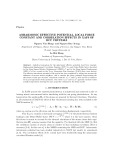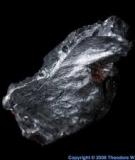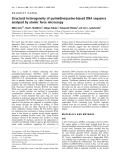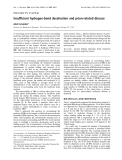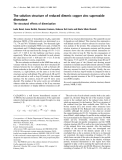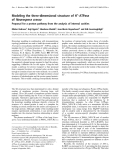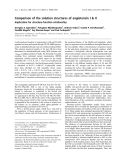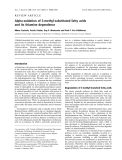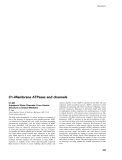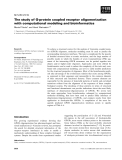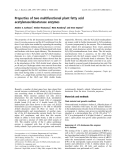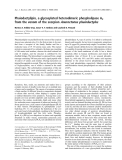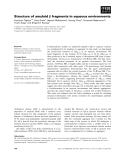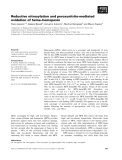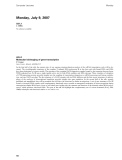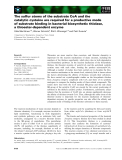
Atomic structure
-
This study aims to generate the system of histone deacetylase enzymes (HDAC) with its cofactor zinc ion using two different parameter models and application of molecular dynamic (MD) study for structure of HDAC2 and vorinostat ligand. Materials and methods: Two non-bonded models, including 12-6-4 Lennard-Jones and cationic dummy atom, were applied for building a solvation system of HDAC2 crystal structure with presence of suber-anilohydroxamic acid (SAHA) and zinc ion.
 9p
9p  vihyuga
vihyuga
 04-03-2025
04-03-2025
 1
1
 1
1
 Download
Download
-
Anharmonic effective potential, local force constant and correlation effects in XAFS of BCC crystals
Analytical expressions for the anharmonic effective potential, local force constant, Displacement-displacement Correlation Function (DCF) CR and Debye-Waller factor described by the Mean Square Relative Displacement (MSRD) σ2 and by the Mean Square Displacement (MSD) u2of bcc crystals in the X-ray Absorption Fine Structure (XAFS) have been derived. The effective interatomic potential of the system has been considered by taking into account the influences of nearest atomic neighbors, and it contains the Morse potential characterizing the interaction of each pair of atoms.
 8p
8p  12120609
12120609
 01-06-2020
01-06-2020
 19
19
 2
2
 Download
Download
-
2D nanomaterials such as graphene and transition metal dichal cogenides (TMDCS) have shown outstanding potential in many fields such as fl exible electronics, sensing and optics due to their desirable physical and structural properties. High quality black phosphorus atomic layers by liquid phase exfoliation include Experimental Section; Supporting Information and Acknowledgements.
 6p
6p  dangthaitrieu
dangthaitrieu
 11-05-2015
11-05-2015
 39
39
 4
4
 Download
Download
-
We report here the direct evidence for the formation of alternative DNA structures in a plasmid DNA, termed pTIR10, containing a 0.23-kb pyrimidine/purine-biased (Pyr/Pur) stretch isolated from the rat genome. Long Pyr/Pur sequences are abundant in eukaryotic genomes, and they may modulate the biological activity of genes and genomes via formation of various types of triplex-related structures. The plasmid DNA in sodium acetate buffer (pH 4.35) was deposited on APS-modified mica, and after drying it was imaged with an atomic force microscope in air. ...
 5p
5p  system191
system191
 01-06-2013
01-06-2013
 34
34
 3
3
 Download
Download
-
Department of Chemistry ‘IFM’, University of Torino, Italy; 2Department of Biology, University ‘Roma Tre’, Rome, Italy; 3Department of Structural and Functional Biology, University of Insubria, Italy Haem binding to human serum albumin (HSA) endows the protein with peculiar spectroscopic properties. Here, the effect of ibuprofen and warfarin on the spectroscopic properties of ferric haem –human serum albumin (ferric HSA–haem) and of ferrous nitrosylated haem –human serum albumin (ferrous HSA –haem-NO) is reported.
 7p
7p  system191
system191
 01-06-2013
01-06-2013
 47
47
 3
3
 Download
Download
-
A structuring and eventual exclusion of water surrounding backbone hydrogen bonds takes place during protein fold-ing as hydrophobic residues cluster around such bonds. Taken as an average over all hydrogen bonds, the extent of desolvation is nearly a constant of motion, as revealed by re-examination of the longest all-atom trajectory with explicit solvent [Y.Duan & P.A.Kollman (1998)Science 282, 740].Furthermore, this extent of desolvation is pre-served across native soluble proteins, except for cellular prion proteins....
 4p
4p  research12
research12
 23-04-2013
23-04-2013
 35
35
 2
2
 Download
Download
-
The solution structure of homodimeric Cu2Zn2superoxide dismutase (SOD) of 306 aminoacids was determined on a 13 C, 15N and 70% 2 H labeled sample. Two-thousand eight-hundred and ®ve meaningful NOEs were used, of which 96 intersubunit, and115dihedral angles provideda familyof 30 conformers with an rmsd from the average of 0.78 0.11 and 1.15 0.09 A Ê for the backbone and heavy atoms, respectively.
 11p
11p  research12
research12
 23-04-2013
23-04-2013
 31
31
 2
2
 Download
Download
-
Homology modeling in combination with transmembrane topology predictions are used to build the atomic model of Neurospora crassaplasmamembrane H + -ATPase, using as template the 2.6 A ˚ crystal structure of rabbit sarcoplasmic reticulum Ca 2+ -ATPase [Toyoshima, C., Nakasako, M., Nomura, H. & Ogawa, H. (2000)Nature405, 647–655].
 13p
13p  tumor12
tumor12
 22-04-2013
22-04-2013
 38
38
 4
4
 Download
Download
-
Conformational analysis of angiotensin I (AI) and II (AII) peptides has been performed through 2D 1 H-NMRspectro-scopy in dimethylsulfoxide and 2,2,2-trifluoroethanol/H2 O. The solution structural models of AI and AII have been determined in dimethylsulfoxide using NOE distance and 3 JHNHacoupling constants. Finally, theAI family of models resulting from restrained energy minimization (REM) refinement, exhibits pairwise rmsd values for the family ensemble 0.26 ± 0.13 A ˚,1.05 ± 0.23 A ˚, for backbone and heavy atoms, respectively, and the distance penalty function is calculated at 0.
 11p
11p  fptmusic
fptmusic
 16-04-2013
16-04-2013
 55
55
 4
4
 Download
Download
-
3-Methyl-branched fatty acids, as phytanic acid, undergo peroxisomala-oxidation in which they are shortened by 1 carbon atom. This process includes four steps: activation, 2-hydroxylation, thiamine pyrophosphate dependent cleavage and aldehyde dehydrogenation. The thiamine pyrophosphate dependence of the third step is unique in peroxisomal mammalian enzymology. Human pathology due to a deficient alpha-oxidation is mostly linked to mutations in the gene coding for the second enzyme of the sequence, phytanoyl-CoA hydroxylase....
 9p
9p  fptmusic
fptmusic
 16-04-2013
16-04-2013
 41
41
 2
2
 Download
Download
-
The high water permeability of certain biological membranes is due to the presence of aquaporin water channel proteins. AQP1 was discovered in human red cells. AQP1 has been thoroughly characterized biophysically, and the atomic structure of AQP1 has been elucidated. Ten homologs have been identified in humans. These are selectively permeated by water (aquaporins) or water plus glycerol (aquaglyceroporins). The sites of expres-sion predict the clinical phenotypes in humans. Individuals lack-ing Colton blood group antigens have mutations in the AQP1 gene. ...
 81p
81p  fptmusic
fptmusic
 11-04-2013
11-04-2013
 43
43
 4
4
 Download
Download
-
To achieve a structural context for the analysis of G-protein coupled recep-tor (GPCR) oligomers, molecular modeling must be used to predict the corresponding interaction interfaces. The task is complicated by the paucity of detailed structural data at atomic resolution, and the large number of possible modes in which the bundles of seven transmembrane (TM) seg-ments of the interacting GPCR monomers can be packed together into dimers and⁄or higher-order oligomers.
 13p
13p  fptmusic
fptmusic
 11-04-2013
11-04-2013
 50
50
 3
3
 Download
Download
-
Apeptide called phaiodotoxin was isolated from the venom of the scorpionAnuroctonus phaiodactylus.It is lethal to crickets, but non toxic tomice at the doses assayed. It has 72 amino acid residues, with a molecular mass of 7971 atomic mass units. Its covalent structure was determined by Edman degradation and mass spectrometry; it contains four disul-fide-bridges, of which one of the pairs is formed between cysteine-7 and cysteine-8 (positions Cys63–Cys71). The other three pairs are formed between Cys13–Cys38, Cys23– Cys50 and Cys27–Cys52. ...
 9p
9p  awards
awards
 05-04-2013
05-04-2013
 44
44
 3
3
 Download
Download
-
The properties of theD6 desaturase/acetylenase from the mossCeratodon purpureusand theD12 acetylenase from the dicotCrepis alpinawere studied by expressing the encoding genes inArabidopsis thalianaandSaccharomyces cerevisiae. The acetylenase fromC. alpinaD12 desaturated both oleate and linoleate with about equal efficiency. The desaturation of oleate gave rise to 9(Z),12(E)- and 9(Z),12(Z)-octadeca-dienoates in a ratio of approximately 3 : 1.
 0p
0p  awards
awards
 05-04-2013
05-04-2013
 42
42
 3
3
 Download
Download
-
Phaiodactylipinwaspurified fromthevenomof the scorpion Anuroctonus phaiodactylus. It is the first protein to be puri-fied from a scorpion of the family Iuridae and has a molecular mass of 19 172 atomic mass units. The mature protein is composedof two subunits, the large one consisting of 108 amino acid residues, whereas the small subunit has only 18 residues, and the structure is stabilized by five disulfide bridges. The heterodimer is expressed froma single message containing 769 base pairs and a signal peptide with 16 and/or 25 amino acid residues. ...
 12p
12p  dell39
dell39
 03-04-2013
03-04-2013
 36
36
 4
4
 Download
Download
-
Conformational studies on amyloidb peptide (Ab) in aqueous solution are complicated by its tendency to aggregate. In this study, we determined the atomic-level structure of Ab28)42 in an aqueous environment. We fused fragments of Ab, residues 10–24 (Ab10)24) or 28–42 (Ab28)42), to three positions in the C-terminal region of ribonuclease HII from a hyper-thermophile, Thermococcus kodakaraensis(Tk-RNase HII).
 9p
9p  dell39
dell39
 27-03-2013
27-03-2013
 39
39
 3
3
 Download
Download
-
Hemopexin (HPX), which serves as a scavenger and transporter of toxic plasma heme, has been postulated to play a key role in the homeostasis of NO. In fact, HPX–heme(II) reversibly binds NO and facilitates NO scaven-ging by O2. HPX–heme is formed by two four-bladed b-propeller domains. The heme is bound between the twob-propeller domains, residues His213 and His266 coordinate the heme iron atom.
 12p
12p  inspiron33
inspiron33
 23-03-2013
23-03-2013
 43
43
 5
5
 Download
Download
-
In the first half of the talk, the current state of our ongoing structure-function analysis of the mRNA transcription cycle will be dis-cussed. The crystallographic structures of the complete 12-subunit RNA polymerase II in free form and with bound DNA and RNA have been determined as atomic models. The structure of the complete Pol II elongation complex bound by the transcript cleavage factor TFIIS explained how Pol II uses a single tunable active site for both RNA synthesis and RNA cleavage.
 12p
12p  galaxyss3
galaxyss3
 19-03-2013
19-03-2013
 44
44
 4
4
 Download
Download
-
Symposia Lectures Monday Monday, July 9, 2007 A2-L1 J. Diffley No abstract available. A2-L2 Molecular bioimaging of gene transcription P. Cramer Gene Center, Munich, GERMANY In the first half of the talk, the current state of our ongoing structure-function analysis of the mRNA transcription cycle will be discussed. The crystallographic structures of the complete 12-subunit RNA polymerase II in free form and with bound DNA and RNA have been determined as atomic models.
 13p
13p  galaxyss3
galaxyss3
 19-03-2013
19-03-2013
 38
38
 2
2
 Download
Download
-
Thioesters are more reactive than oxoesters, and thioester chemistry is important for the reaction mechanisms of many enzymes, including the members of the thiolase superfamily, which play roles in both degradative and biosynthetic pathways. In the reaction mechanism of the biosynthetic thiolase, the thioester moieties of acetyl-CoA and the acetylated catalytic cysteine react with each other, forming the product acetoacetyl-CoA.
 13p
13p  vinaphone15
vinaphone15
 28-02-2013
28-02-2013
 50
50
 3
3
 Download
Download
CHỦ ĐỀ BẠN MUỐN TÌM









